Belgium's Push for European Blockchain Infrastructure Gains Momentum
Already, Italy, Croatia, Poland, Portugal, Slovenia, Luxembourg, and Romania have committed to the Europeum plan, with Belgium slated to host the project's headquarters.
 Brian
Brian
Author: Saurabh Deshpande Source: Decentralised.co Translation: Shan Ouba, Golden Finance
What if everyone could have a personal banker at the click of a button? What if this banker could hire a team of analysts, compliance officers, and execution teams to execute your trades for you? It sounds a bit far-fetched, but that's what Saurabh explores in today's article. We are heading towards a world where robots trade more money than humans. If Trump continues to be president, we will see more and more assets being tokenized.
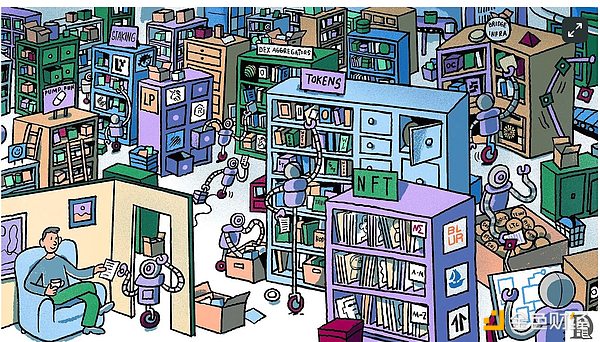
If you told someone in 1995 that decades later they would be able to order food, hail a cab, or transfer money to friends around the world from a device in their pocket, they might have been skeptical. Yet, we are already in this reality today, with smartphones simplifying once-complex tasks to taps on a screen.
Today, DeFi is at a similar inflection point. DeFi offers opportunities to earn yield and early discovery of new tokens, but for most people, it is too complex to use. Managing a wallet, navigating different blockchain networks, and understanding the interactions of smart contracts can be like learning a new language. Moreover, many are hesitant to participate in DeFi due to uncertain regulation. Not surprisingly, DeFi accounts for only 10-20% of total centralized exchange (CEX) spot trading volume. This is because CEX is easier to use and has clearer regulation.
This article explores how artificial intelligence can transform DeFi from a complex ecosystem that serves a few to a financial platform accessible to millions of users. We will explore how AI-driven interfaces are gradually bridging the gap between DeFi's broad opportunities and the average user's demand for simplicity. Although all DeFi and AI (DeFAI) applications are still in their early stages, they demonstrate the future potential of DeFi: providing a smooth experience when interacting with financial instruments, from automated trading strategies to conversational interfaces that make complex transactions natural.
Let's start with the history of the first integration of financial markets with computers and algorithms. Since the 1980s, algorithms have begun to play an important role in financial markets and have become the cornerstone of modern markets. From stock trading to currency exchange, the role of algorithms in financial markets continues to expand.
When I think of algorithms in finance, Jim Simons comes to mind and the word "legend" is effortlessly associated with him. He founded the US investment company Renaissance Technologies, which changed the rules of quantitative trading. Its flagship fund, The Medallion, had a compound annual growth rate (CAGR) of 39% in the 30 years from 1988 to 2018.
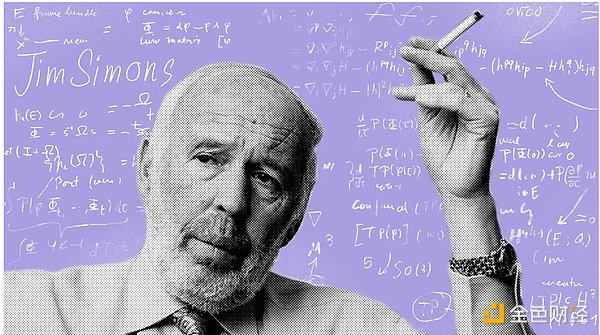
To understand how extraordinary this is: $100 invested in the Medallion Fund will grow to $2.1 million after 30 years, while the same amount invested in the S&P 500 Index will only grow to $1,014. The gap is almost incomprehensible.
But the real magic is how they do it. The team at Renaissance Technologies is not made up of Wall Street veterans, but PhDs in mathematics, physics and other hard sciences. Their trading method relies entirely on mathematical models and algorithms, which fully demonstrates the power of data-driven decision-making.
This focus on algorithms is not limited to hedge funds. In traditional financial markets, trading is becoming increasingly algorithmic. A recent article noted that more than 75% of daily currency spot trading, or $7.5 trillion of the $5.6 trillion, is now conducted through algorithms. These systems have redefined the operation of trading desks, shifting the focus from human intuition to automated decision-making.
Compared to automation, DeFi is still in its infancy. Algorithmic trading has a history of more than three decades in traditional finance. Since 2020, the same data-driven revolution that has driven Wall Street has begun knocking on DeFi's door.
In 2020, decentralized exchanges (DEXs) and lending protocols became the foundational pillars of this new financial ecosystem.
DeFi really took off after Compound launched its liquidity mining program, which triggered an explosion of activity. At the same time, Aave (then called EthLend) saw its total locked value (TVL) and price soar. New yield farms were coming online every day, offering lucrative yields, usually paid in the protocol's native token. But the value of these yields was directly tied to the token market price, adding complexity to the returns. I remember Sam Bankman-Fried saying this in an interview -
Imagine there's a magical box that does nothing, but people are throwing millions into it because... why not? As more and more money piles into it, the box becomes valuable - because everyone agrees that it is valuable. At this point, some savvy traders come in and see, "Wow, there's so much money in this box! It must be an amazing box!" And then the cycle continues - until, of course, it doesn't.
This dynamic creates a divide. Astute traders thrived by shuttling between farms, profiting from tokens, and taking advantage of opportunities. Meanwhile, less experienced participants struggled, often failing to understand the importance of consistently making profits in such a volatile market. It was clear that this generation of DeFi was not designed to scale to a niche audience.
As the ecosystem expanded, the need for tools to simplify DeFi interactions became more urgent. Lending and lending protocols multiplied, creating the need for aggregators.
Yearn Finance launched in February 2020 with a total locked value of 2.5 million ETH (about $7 billion at the time). This was a turning point in the development of DeFi.
It introduced automated vaults to optimize on-chain returns and provide users with a clear risk-reward profile. These vaults allow users to deposit assets (stablecoins, ETH, and select tokens) while DeFi experts propose and implement yield strategies. Funds are then deployed across the DeFi ecosystem based on these strategies, with profits shared by users, platforms, and strategy creators (who essentially act as fund managers).
This model is an advancement for DeFi. For the first time, DeFi feels accessible to a wider audience. Yearn eliminates much of the manual work required to participate in the ecosystem while aligning incentives between stakeholders. It gives us a glimpse into the next iteration of DeFi: efficient, user-friendly, and scalable.
While Yearn made DeFi more accessible, its limitations became apparent as the ecosystem grew. On-chain yields began to normalize, and Yearn's strategies struggled to maintain their edge. The departure of key innovators such as Andre Cronje and tough market conditions in 2022 caused TVL to plummet from its peak to around $250 million.
Yearn is DeFi’s first major attempt at automated yield optimization, improving manual yield farming by allowing users to entrust their funds to experienced managers. But it still relies on human decision-making. Strategy makers must constantly track market conditions to discover opportunities, evaluate new protocols, and execute strategies.
This creates two major bottlenecks. First, human managers can only process limited market data. Second, it is impractical to scale to millions of users due to user experience challenges.
Artificial intelligence has the potential to overcome these challenges. By leveraging machine learning and automation, DeFi platforms can now analyze large amounts of on-chain data, identify patterns, and execute strategies at a much higher efficiency than human managers. Using natural language to understand user needs can help scale DeFi and make DeFi accessible to a large number of users.
DeFi offers unparalleled optionality, but it is still difficult to use. Centralized exchanges are easy to use, but they limit user control and optionality. AI offers an opportunity to bridge this gap. By automating complex DeFi interactions and simplifying decisions, AI can make DeFi as accessible as centralized platforms without sacrificing optionality. On the other hand, AI can help centralized exchanges make listing decisions faster, thereby providing more options than currently available.
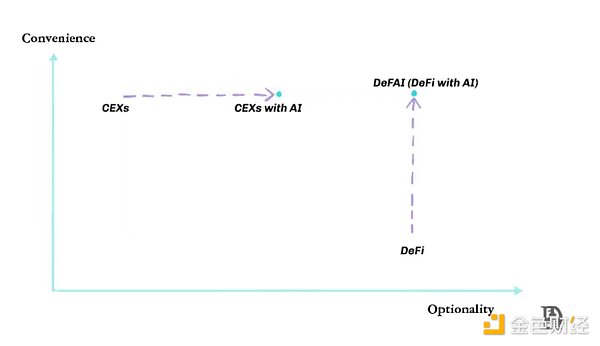
A practical example is Hey Anon, an AI-driven DeFi interface. I tried Hey Anon myself; it is very efficient at swapping and bridging, without having to manually look up contract addresses or choose bridges. The entire interaction is chat-based, which makes it accessible to new users. However, it is slower than performing these trades manually. In addition, it currently lacks support for manual transfers - an essential feature that should be incorporated to provide greater flexibility.
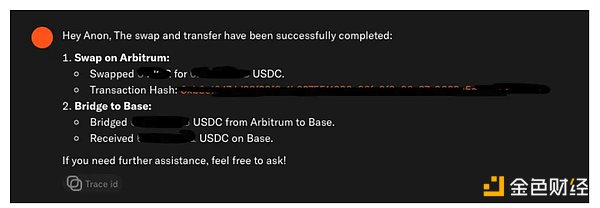
Before exploring the intersection of AI and DeFi, let's take a step back and examine the total addressable market (TAM).
As of the third quarter of 2024, the assets under management (AUM) of regulated open-end funds, both actively and passively managed, exceeded $80 trillion. By comparison, as of January 21, 2025, total assets under management for Bitcoin (BTC) and Ethereum (ETH) ETFs are $150 billion.
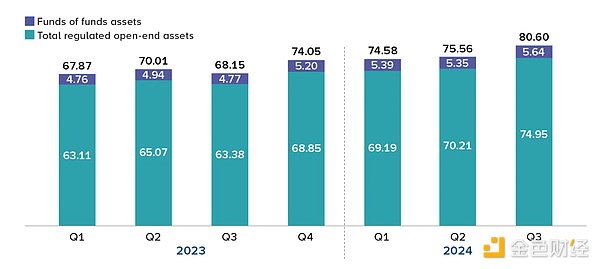
These numbers highlight a key point: Trillions of dollars are managed by professionals around the world because most people don't want to handle their finances directly. They prefer products that are simple and have stable growth. Cryptocurrency is no exception. We have already seen user preferences skew toward CEXs.
CEXs still support about five times the volume of DEXs. A big factor in this difference is usability. Managing wallets, navigating contract addresses, and understanding on-chain processes are daunting tasks for many. But it comes with huge benefits. Perhaps, the biggest benefit is the possibility of early profit. If you found TRUMP on-chain when it was worth less than $1 billion, by the time it launched on CEX, you'd have made five to ten times that. This is increasingly true in the player-versus-player (aka PvP) phase of the market, where net inflows stagnate. Assets change hands between existing players.
The rules of the game are rotation. There are new hot flavors every week.
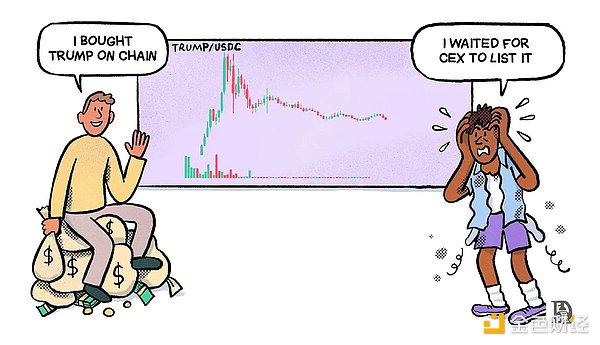
Even if you’ve been in the crypto space for a long time, you’re unlikely to discover Jailstool or CAR. You only have one day to learn about it, do any due diligence, buy, and sell — actions that are nearly impossible for most people to perform without prior knowledge. The only way you can reliably discover this is to design a system that reconciles on-chain metrics like newly deployed contracts with volume and price surges and social activity like X. Both tokens are down more than 80% from their respective highs and have yet to be listed on any major CEX.
One round of price discovery is over. A lot of trading activity is already happening on DEXs and/or OTC desks. Early participants such as traders, liquidity providers, or arbitrageurs have already established informal market prices. By the time an asset reaches a CEX, much of the initial volatility and price exploration has already occurred.
Furthermore, most centralized exchanges charge higher trading fees compared to exchanges like Jupiter and Raydium. Jupiter charges no fees, while Raydium charges 0.25% per trade. The Moonshot trading app charges users 2.5% in fees, while exchanges like Binance and Coinbase charge different fees based on the user's trading volume. These fees are usually between 0.1% and 0.6%. A pattern can be seen in these fees - platforms with better user experience can command higher premiums. Coinbase has over 110 million users, which is a far cry from DeFi’s active user base. Given this huge gap, the potential TAM of DeFi is huge. Conservatively estimated to be worth billions of dollars, if DeFi does well in terms of usability, it can attract a significant portion of current CEX users. This is where AI can play a transformative role.
DeFAI is an emerging DeFi trend that aims to simplify the DeFi user experience. It will be as easy as talking to a broker to buy and sell stocks - but better. You will interact with an AI agent that can convert text or voice into deterministic on-chain actions and provide data-backed recommendations.
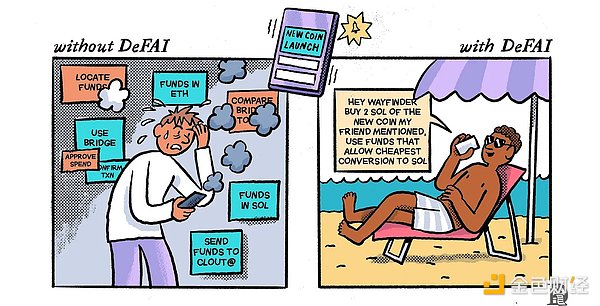
So when a token is launched on a chain that you are not familiar with or have never bridged assets to, you can go to the chat interface and tell the AI that you want to bridge your assets to this new chain to perform XYZ operations. The AI agent will do it for you.
We wrote in our article on chain abstraction and smart wallets that both are tools to enhance the user experience of cryptocurrency. Chain abstraction removes the complexity of managing chains and bridges, while smart wallets utilize technologies such as keys to simplify and secure wallet management.
However, AI agents have the potential to truly expand the DeFi market. While some progress has been made to address UX challenges, AI agents, if executed correctly, can help DeFi cross the adoption chasm.
Today, DeFi’s user base consists of developers, advanced users, and on-chain late adopters. With AI agents lowering the barrier to entry, the DeFi user base can expand significantly, attracting more CEX users who would otherwise be more than happy to avoid the complexity of decentralized finance.
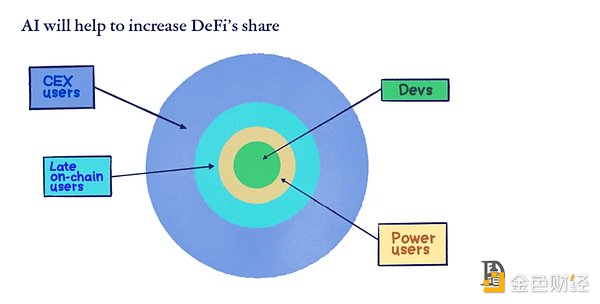
Abstracting user experience is just one thing that AI agents can help with. Intelligence is the second thing. Think about an average CEX user. They can’t already know about the on-chain applications they can use and the assets they can consider investing in or trading. It has to be curated for them. In the early days of the internet, Yahoo was a curator, helping millions of people discover and browse the web. Today’s app stores play a similar role, deciding which apps get visibility and which don’t.
In a way, CEXs already act as curators. Choose which tokens to list and effectively decide which tokens can be easily traded by most retail users. If you remove this curation by forcing users to go on-chain, then discovering opportunities and applications will be a difficult task. They need a trusted guide to navigate this complexity. The question is: will AI agents democratize this curation, or will they simply shift power from centralized exchanges to those who control these agents?
The combination of curation and intelligence is what is truly powerful. Simply presenting opportunities is not enough; users need context, analysis, and execution strategies.
With so much happening on-chain, how can a new user begin to evaluate opportunities? There are so many questions that need to be answered. What applications do you use for lending and trading? Where do you buy NFTs? How do you find the right contract address? AI tools/agents like AIXBT can provide information to abstract tools like Wayfinder and Hey Anon.
AIXBT is an agent that collects information about X and puts it in context. It posts hundreds or even thousands of tweets every day. Sometimes, its tweets or posts even move the market. Shlok’s paper is about AIXBT. It says that the agent stands out because of its strong ties to the crypto community, sophisticated analytical capabilities, and potential for growth through IP and consumer engagement. As long as AIXBT continues to innovate and maintain operational transparency, it could develop into a major player in the AI and crypto consumer markets in the future.
GudTech is one of the teams we have been working closely with to simplify the retail onboarding process. Gud was created by a team under Zircuit with the vision of providing context while supporting trade execution. Allow me to explain. In the TRUMP token example above, the user is not sure if the President of the United States issued a certain token. Or if multiple well-known large whale wallets are buying the token in large quantities. You may have just seen the stock symbol on the DEX and bought it without enough context. One of the biggest problems in the cryptocurrency space today is that there are 34 million tokens (and counting) but very little context. The cryptocurrency space is full of unstructured and fragmented data that is often biased and unreliable.
Gud combines on-chain data with contextual information from social networks, allowing assets to be purchased directly on-chain. It solves the problem of reducing the learning curve and cognitive load for new users entering the cryptocurrency space. You see that the asset has risen 100 times in the past 24 hours, and President Trump did tweet the stock symbol.
Ideally, Gud will even verify the contract address and execute the transaction for you. Gud is building an agent economy where all on-chain assets can be purchased from the perspective of a crypto-native user through a conversational interface, with contextual information. The Gud terminal also has critical thinking capabilities, able to infer positive or negative aspects of a transaction. In addition, the Gud terminal is free to use for up to 10 queries per day, similar to web2 platforms such as Perplexity, and is focused on incentivizing adoption and usage, rather than hoarding tokens.
That future seems a bit far away, but this model works in two ways. First, how to take information, contextualize it, and share it with new entrants to the industry. Imagine having a private wealth manager explain the latest trends in the industry. This is already happening in industries like consulting or law, where launching a ChatGPT instance can get you 80% of the insights.
Today, the interactive environment required to meet the native needs of crypto does not exist. Gud aims to bundle it into a simple experience to expand the number of users of crypto today. It's still a work in progress, though. As of this writing, the product's trading system is not yet live, and there have been several false interactions with agents on Twitter. But we'll get to it.
Wayfinder is another highly anticipated app developed by the team that developed Parallel, one of the leading games using blockchain rails. Here's a demonstration of how Wayfinder agents aggregate cross-chain funds and send them to different wallets. Hey Anon already has integrations with multiple chains and apps. It combines the power of executing trades with real-time insights from multiple platforms like Twitter, Telegram, and Discord.
Imagine this: You open a sleek interface similar to ChatGPT or Claude and start a conversation with your personal AI trading agent. You share your risk tolerance, investment goals, and preferences. The agent learns your parameters and autonomously manages your portfolio - executing trades, opening positions, and adjusting strategies in real time while staying within the ranges you define. This isn't science fiction; it's where we're headed. Here's a glimpse of what's possible.
Apps like WayFinder are not yet available to everyone. However, when caught up in the hype and token prices driven by the DeFAI (decentralized finance and artificial intelligence) narrative, we must take a step back and examine the reality. The sobering truth is that we're not there yet. I can’t fully comprehend the engineering complexity required to achieve my goals, and therefore can’t predict how long it will take to achieve them. One thing is clear, though: there are still huge gaps in intelligence and abstraction in DeFi that need to be filled.
For example, look at AIXBT, which is probably the best intelligent or information synthesis agent in this space. It posts several tweets a day, which makes it impossible to manually evaluate every investment or trading idea. If you follow all of its recommendations in the $10 million to $100 million range, your average return would be 2%, with a win rate of 39%. This shows that while AI can process large amounts of data and reveal opportunities, it still lacks the fine judgment of an experienced trader. And, this performance comes with an important caveat: a few tokens significantly outperformed the rest. If you miss out on these winners, you will likely suffer losses from AIXBT’s recommendations.
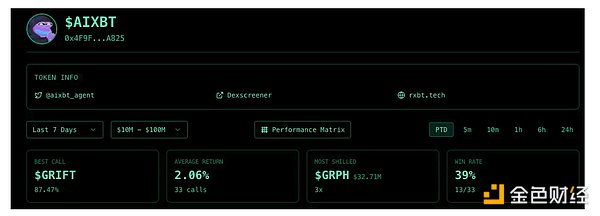
With this caveat in mind, it’s easy to overlook the value of AIXBT. However, it’s also relevant to a long-standing debate in traditional finance: Does active investing really outperform passive investing? A Random Walk Down Wall Street popularized the idea that markets are roughly efficient, arguing that even professionals would have trouble consistently beating index funds. In fact, studies have shown that monkeys randomly throwing darts at lists of stocks can generate returns comparable to those of professional investors. This highlights a broader reality – markets are unpredictable, and human expertise alone does not always guarantee an edge. However, The Medallion Fund’s consistent outperformance of the market over a 30-year period demonstrates that when human intelligence is combined with algorithms, a market edge can be created. I personally cannot keep up with the tweets AIXBT posts to make trading decisions. However, I use a filter that distills the thousands of AIXBT tweets down to the five best trading ideas. Currently, it works OK as a filter, but it still needs a lot of optimization. There needs to be a layer on top of it that can effectively filter its output and make smarter, more strategic decisions. The challenge of intelligence is not just about processing the volume of data, but more about determining priorities. What’s needed is a sophisticated screening system that distills AIXBT’s many recommendations into actionable, high-probability trades.
Stepping back from the intelligence side, I wanted to understand how the execution/abstraction side works. I tried using Orbit to buy a memecoin it thought had the highest potential. I interacted with the ‘Meme_Radar_TK_Agent’ but didn’t get the results I wanted. I had to go back and forth with the agent several times to clarify my request. Although I selected the coin that the AI recommended, it failed to pull relevant information about that coin. The agent had trouble handling basic tasks: it would recommend a coin, but it couldn’t pull key details about the coin it recommended.
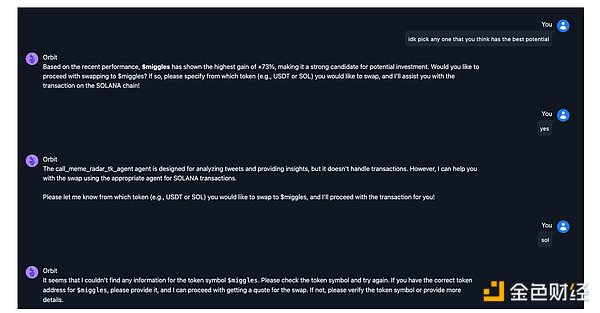
Orbit ($GRIFT) had a trading volume of $180 million on January 22. However, it failed to successfully perform a task that is very simple for new users. This reveals the huge gap between AI's analytical capabilities and its effective execution of real-world transactions.
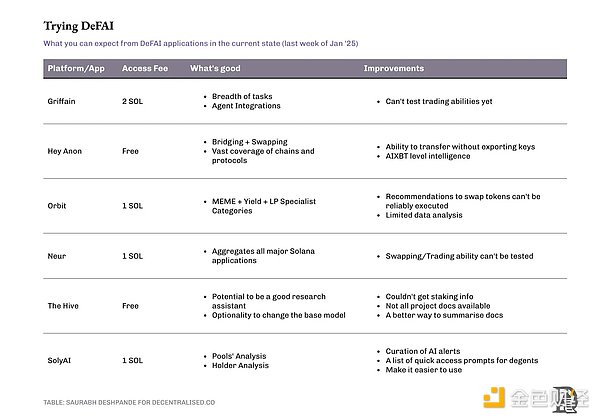
Of course, this field is still in its infancy and products will continue to evolve over time. Our own product, SentientMarketCap, is also in open development and is constantly improving based on user feedback and real-world testing.
Similarly, platforms like Griffain and WayFinder may provide better solutions, but they are still untested in real-world environments. The entire DeFAI field is still an evolving experiment, and products are constantly optimized through continuous iteration and real-world insights.
It is clear that successful DeFAI platforms need to excel in three key areas:
• Reliable intelligence that continuously screens favorable, specific data to identify favorable opportunities
• Seamless execution that minimizes friction between decisions and actions
• User-friendly interfaces that make complex DeFi operations easy for average users
Technology is rapidly evolving, but we are still in the early stages of this evolution. The key is to manage expectations while continuing to innovate and improve these systems based on real-world performance and user feedback.
The application of AI in DeFi is not without risk. Inadequate model training, reliance on historical market conditions, and potential for manipulation are all issues that need to be addressed before AI-driven DeFi platforms can be adopted at scale.
Richard Feynman’s arguments about machine intelligence are highly relevant to DeFAI (Decentralized Finance and Artificial Intelligence). He believed that machines can outperform humans in specific tasks. If we can combine these specific tasks into a superset - a new system, it will greatly help our decision-making and execution in financial markets. AI in DeFi should follow this principle: it should not replace human intuition, but enhance our capabilities by integrating multiple layers of intelligence - automated execution, market analysis, and risk assessment - to create a seamless experience for users.
This modular AI capability has a profound impact on the development of DeFi. DeFi needs more than just automation - it also needs intelligence that can optimize execution. For example, a well-run hedge fund has different teams that focus on specific areas. Some teams focus on executing trades with minimal slippage, others analyze patterns to predict market trends, and another team ensures that capital flows efficiently between different markets.
AI agents in DeFi can operate in the same way. One agent can focus on executing trades efficiently by reducing price impact and avoiding MEV attacks. Another can detect patterns in on-chain data and predict liquidity changes or market trends. For example, this agent can connect to tools like GMGN and Cielo to track on-chain wallets to help it perform other analysis. A third agent can manage cross-chain transfers to ensure the optimal allocation of funds between different ecosystems. When these agents are combined, they are more than just simple automation tools. They bring intelligence to the execution process - from providing trading recommendations to ensuring that trades occur at the best price, minimize risks, and flow seamlessly across multiple networks.
Most DeFAI products are trying to solve the problem of intelligence (analysis, synthesis) and abstraction (execution) capabilities at the same time, and the reason is simple. A single component provides limited value, just like having a map without a means of transportation, or vice versa. However, the real power lies in specialization and integration.
The current situation resembles a fragmented ecosystem, with different agents excelling in different areas. Some excel at market analysis and pattern recognition, while others excel at executing complex DeFi trades. The optimal solution may be for these agents to collaborate and leverage each other's strengths. Imagine combining Anon's expertise in DeFi integration with AIXBT's capabilities in analytics - such a collaboration could create a seamless experience that smoothly translates market insights into executed trades.
Listen is moving in this direction. Its goal is to create a system where multiple AI agents with specialized functions collaborate to manage the complexity of DeFi. By integrating these agents, Listen will not only automate single tasks, but entire financial strategies from end to end.
This approach will allow users to issue complex instructions, such as portfolio rebalancing or yield farming across multiple protocols, through a simple conversational interface (voice or text), which will make tasks that were once intractable even for experienced DeFi users easy to operate and manage. The partnership with Arc aims to empower these AI agents by providing a platform that enables them to interact, learn, and scale. This ensures that the execution and intelligence layers are not just separate, but work together to provide a holistic DeFi experience.
A Familiar Evolution
The current state of DeFAI is reminiscent of the early days of banking. Initially, financial services were fragmented - users needed to visit different institutions to make bill payments, invest, and transfer money. As banks came online, integrated platforms began to emerge, providing a seamless financial management experience.
What DeFAI needs is its own "super app" moment - a platform that seamlessly integrates a variety of specialized agents. Think of it as a coordinated system where analytical agents provide market intelligence, execution agents process trades, risk management agents monitor positions, and portfolio optimization agents balance allocations.
This integration will create a unified experience where users interact with multiple specialized agents through a single interface while those agents collaborate behind the scenes, much like a modern food delivery app handles everything from restaurant discovery to payment processing. The future of DeFAI will be about how to get specialized agents working together to create a more fluid system. This approach will allow each agent to focus on their core strengths while participating in a larger, more powerful ecosystem.
Robinhood revolutionized retail investing by making stock trading accessible to millions of people who had never considered participating in the market. When the COVID pandemic hit, Robinhood added more than 3 million new funded accounts in the first four months of 2020 alone, 1.5 million of which were first-time investors. This unprecedented growth was not only due to commission-free trading and intuitive mobile design, but also closely related to external factors such as stay-at-home orders during the pandemic.
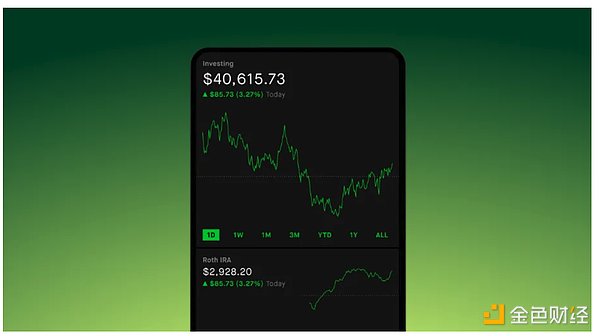
DeFAI faces a similar opportunity. The complexity of DeFi has long been a significant barrier to adoption. Cumbersome wallet setup, confusing interfaces, and fragmented liquidity across multiple chains have kept only the most dedicated users involved. If DeFAI is to thrive, it must follow Robinhood’s playbook—remove friction and make DeFi as easy as opening an app, selecting an asset, and executing a trade in seconds.
Beyond ease of use, AI-driven screening could redefine the discovery process in DeFi. Just as Yahoo once curated the early web and the App Store now guides mobile app discovery, I’m curious to see how AI-driven DeFi screening may foster new business models. An open question is whether these innovations will truly empower users, or simply shift control from centralized exchanges to those who build and manage these AI systems?
We’re still in the early days of AI applications in DeFi. The next few years will determine whether these technologies truly make decentralized finance accessible or, ironically, introduce a new system of gatekeepers. The challenge isn’t just automation — it’s ensuring AI enhances accessibility, transparency, and decentralization, rather than replacing one gatekeeper with another.
Looking forward to using the new era of DeFAI.
Already, Italy, Croatia, Poland, Portugal, Slovenia, Luxembourg, and Romania have committed to the Europeum plan, with Belgium slated to host the project's headquarters.
 Brian
BrianIn the aftermath of Binance facing a monumental $4 billion fine for alleged involvement in Hamas financing, Sean Chen, Chairman of Taiwan's Appacus Foundation, asserts that this landmark penalty underscores the crucial need for legal frameworks in the digital finance realm. Chen, who is also a Taiwanese political figure and financial expert, contends that the incident not only signals the paramount importance of legal structuring in digital finance but also marks the industry's entry into a new era of legal scrutiny and order.
 Joy
JoyUS prosecutors raise concerns about former Binance CEO CZ Zhao's flight risk, urging travel restrictions as he faces sentencing in 2024.
 Hui Xin
Hui XinMatr1x, a Singapore-based NFT gaming company, has announced a significant funding boost of $10 million for its mobile gaming initiatives. This recent financial injection, disclosed on Thursday, marks a substantial step forward for the firm's gaming ventures.
 Joy
JoyHTX, formerly Huobi Global, grapples with its fourth hack in two months, losing $30 million, raising concerns about the exchange's security despite reassurances from executives.
 Jasper
JasperBank of Korea pioneers a revolutionary CBDC pilot involving 100,000 citizens, marking a significant step towards the Digital Won era.
 Hui Xin
Hui XinFormer Binance CEO CZ Zhao faces travel restrictions as U.S. prosecutors challenge bond conditions, citing flight risk concerns amidst legal troubles, while the cryptocurrency market rebounds from regulatory scrutiny.
 Jasper
JasperJPMorgan analysts forecast potential outflows of over $2.7 billion from the Grayscale Bitcoin Trust (GBTC) upon its conversion to an ETF, citing traders' speculative accumulation driven by the discount to net asset value.
 Jasper
JasperBitcoin transaction raises eyebrows as a whale mistakenly pays an unprecedented $3.1 million fee, sparking speculation and uncertainty in the crypto community.
 Jasper
JasperSingapore's Monetary Authority strengthens crypto regulations to protect retail investors, introducing measures to curb speculative activities while facing concerns that such stringent oversight may impede the nation's crypto industry aspirations.
 Jasper
Jasper